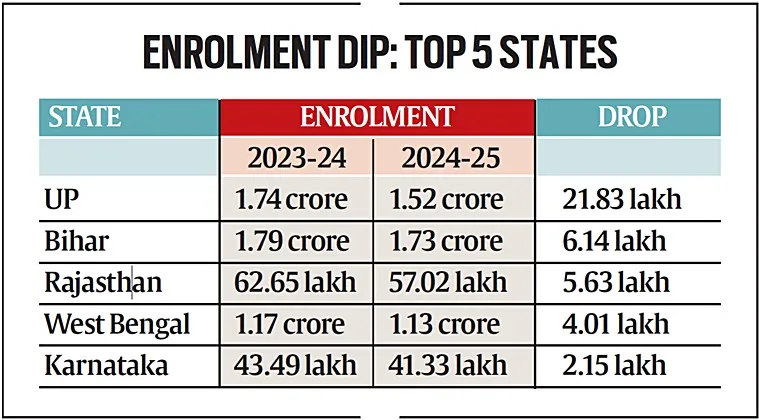Important Facts For Prelims
Enrolment Drop in Government Schools and PM-POSHAN
- 21 May 2025
- 4 min read
Why in News?
The Ministry of Education (MoE) convened a discussion with States and UTs to review the performance, planning, and budget of the Pradhan Mantri Poshan Shakti Nirman (PM-POSHAN) scheme, revealing a decline in government school enrolment in 23 States.
What are the Trends in Declining Government School Enrolment?
- Decline in School Enrolment: The Ministry of Education revealed a significant enrolment drop in 23 States and UTs for 2024–25, with some seeing declines of over 1 lakh students.
- It is led by Uttar Pradesh (21.83 lakh), Bihar (6.14 lakh), Rajasthan (5.63 lakh) and West Bengal (4.01 lakh).
- Factors Behind Enrolment Decline:
- Change in Data Collection Methodology: The transition from school-wise (total numbers) to student-wise reporting (name, address, parents’ names and Aadhaar details) likely eliminated outdated records and false entries, such as “ghost” students not actually attending school.
- Shift to Private School: Several States suggest that post-Covid years have seen a shift in enrolment from government to private schools, reversing trends observed during the pandemic.
What is the PM-POSHAN Scheme?
- About: PM-POSHAN is a centrally sponsored scheme for providing one hot cooked meal to students up to Class 8 Government and Government-aided schools.
- Launched for an initial five-year period (2021–22 to 2025–26), it replaced the earlier midday meal scheme (MDM).
- Launched in 1995, the MDM Scheme is the world’s largest school meal programme, aimed at universalizing primary education.
- Launched for an initial five-year period (2021–22 to 2025–26), it replaced the earlier midday meal scheme (MDM).
- Cost Sharing: Its cost is shared by the Centre and States on a 60:40 basis, with the Centre supplying foodgrains.
- Entitlements: Primary (class 1-5) and upper primary (class 6-8) students receive 100g and 150g of food grains daily, ensuring 700 calories.
- It also provides extra nutrition (e.g, milk or eggs) for children in aspirational districts and areas with high anemia rates.
- Key Provisions:
- Nutritional Gardens: It promotes school nutritional gardens to provide students with additional micro-nutrients.
- Tithi Bhojan: The Tithi Bhojan program, where communities provide special food to children on special occasions like festivals, is being widely promoted.
- Nutrition Expert: Each school will appoint a nutrition expert to monitor Body Mass Index (BMI), weight, and haemoglobin levels.
- Social Audit: Social audits are now mandatory in all schools to assess scheme implementation, with college students enlisted for local monitoring.
- Vocal for Atmanirbhar Bharat: It encourages involvement of Farmers Producer Organizations (FPOs) and Women Self Help Groups (SHGs), and promotes locally grown traditional foods to boost local economies
UPSC Civil Services Examination, Previous Year Questions (PYQs)
Prelims
Q. Which of the following are the objectives of ‘National Nutrition Mission’? (2017)
- To create awareness relating to malnutrition among pregnant women and lactating mothers.
- To reduce the incidence of anaemia among young children, adolescent girls and women.
- To promote the consumption of millets, coarse cereals and unpolished rice.
- To promote the consumption of poultry eggs.
Select the correct answer using the code given below:
(a) 1 and 2 only
(b) 1, 2 and 3 only
(c) 1, 2 and 4 only
(d) 3 and 4 only
Ans: (a)







